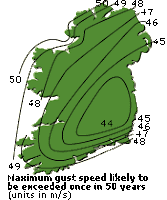Current:
Dublin, Ireland currently reflects the climatology of a maritime climate with the Gulf Stream helping moderate its temperatures. Highs for Dublin currently range anywhere from 23 to 59 F, and the lows range anywhere from 12 to 51 F. The annual precipitation in inches is about 0 annually and the country of Ireland only sees on average 10 days of snow a year, if that.
Lat: 53.4 N and Long: 6.3 W ( Dublin, Irealand is located right about where the word "Europe" appears.)
 Current Climograph of Temperatures and Precipitation: As you can see on this graph Dublin sees a good amount of their rain fall in the winter months and sees less in the summer when the temperatures are warmer.
Current Climograph of Temperatures and Precipitation: As you can see on this graph Dublin sees a good amount of their rain fall in the winter months and sees less in the summer when the temperatures are warmer.100,000,000 years ago:
About a hundred million years ago the earth was in the late Early Cretaceous period (105Ma) and it was during this time that most of southern England was under water as it said the Atlantic Ocean had grown larger at this time. They base this fact off the chalk cliffs in Southern England which contain fossils of sea life. Some these same white chalk cliffs can be found in North East Ireland.
Based off of this information and the close proximity of Ireland to Southern England, I believe that the island of Ireland was also underwater as well at this time, and the only information that I have to dispute that guess is an article that states that a tiny portion of the island of Ireland was above water while the rest was submerged.
“Only a tiny portion of the landmass we know as Ireland today was above the water surface, a small, remote island situated on what would eventually become the eastern part of the county of Wicklow.” Article Source: http://EzineArticles.com/6039859
So based off this information, I would have to say that the climate of Dublin a 100 million years ago was oceanic and full of sea life, and I would also say based off the research and the fact that this era is right before an ice age that the ocean are much warmer and the Gulf Stream is slowly beginning to slow down as the temperatures of the oceans increase.
Lat: 52N Long: 8W
Based off the notion that 98% of Ireland is submerged and where Ireland is located today, the I believe that Ireland was located 100 million years ago in the area above the equator between the continents near the light blue water.
Based on what I have read about this era temperatures for the ocean were a lot warmer than they are today, I guessed that in the winter months the water would be colder due to the amount of sunlight but in summer the temperatures would be up in the 70’s to 90’s because of extended hours of sun and based off the fact that temperatures of oceanic water reached into 100’s during this period.
http://en.wikipedia.org/wiki/Cretaceous
100 Million Years from now:
Based on what I have read, in 100 million years from now the mid-Atlantic ridge will begin subducting the ocean floor at a faster rate bringing the continents together—just like Pangaea. What this means for my location is relocation to above where Europe currently sits, near the North Pole. If this event does occur, it would mean a complete climate change. I would guess that with its location moving farther north would change this moderate climate to a much colder climate with temperatures falling below 20F on a daily basis. I would say that there would be much more snow then is currently seen in Ireland today—which is 10 days—and get about 2 to 3 inches of precipitation annually which is higher than it is today.
I borrowed this image from the blog on France since Dublin was in the same region.
This images shows that all of Northern Europe moved further north closer to the North Pole.
In this image you can see England up near where the North Pole is, and since Ireland and England were close in proximity my guess is that as England moved further north so did Ireland. As for the longitude and latitude I would imagine it would be around 4 or 5 N and 10 to 15 W.
 Based on Ireland being further north, I imagine the amount of precipitation to increase as the snowfall would increase. I also believe the temperatures will drop significantly in the negatives because of its new polar nature.
Based on Ireland being further north, I imagine the amount of precipitation to increase as the snowfall would increase. I also believe the temperatures will drop significantly in the negatives because of its new polar nature.Word Count: 731
Citations:
http://www.scotese.com/future1.htm
http://www.youtube.com/watch?v=uGcDed4xVD4































